Greater Than/Less Than
In math, "greater than" and "less than" are used to compare two numbers. They are denoted by the symbols ">" (greater than) and "<" (less than).
When comparing two numbers, if the first number is larger than the second number, we use the ">" symbol to show that the first number is greater than the second number. For example, 5 > 3 means "5 is greater than 3".
Conversely, if the first number is smaller than the second number, we use the "<" symbol to show that the first number is less than the second number. For example, 2 < 7 means "2 is less than 7".
It's important to remember that the open end of the symbol always points to the smaller number, and the closed end points to the larger number.
Here are a few examples:
- 6 > 4 (6 is greater than 4)
- 9 < 12 (9 is less than 12)
- 3 > 3 (3 is not greater than 3, they are equal)
◂Math Worksheets and Study Guides Third Grade. Greater Than/Less Than
Study Guide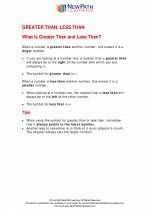 Greater Than/Less Than
Greater Than/Less Than  Activity Lesson
Activity Lesson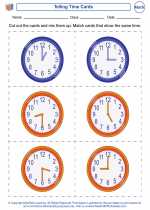 Telling Time Cards
Telling Time Cards  Worksheet/Answer key
Worksheet/Answer key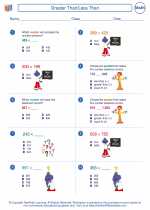 Greater Than/Less Than
Greater Than/Less Than  Worksheet/Answer key
Worksheet/Answer key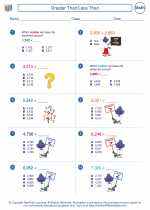 Greater Than/Less Than
Greater Than/Less Than  Worksheet/Answer key
Worksheet/Answer key Greater Than/Less Than
Greater Than/Less Than  Worksheet/Answer key
Worksheet/Answer key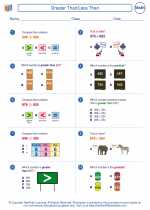 Greater Than/Less Than
Greater Than/Less Than  Worksheet/Answer key
Worksheet/Answer key Greater Than/Less Than
Greater Than/Less Than  Worksheet/Answer key
Worksheet/Answer key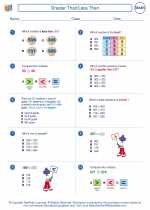 Greater Than/Less Than
Greater Than/Less Than 

 Activity Lesson
Activity Lesson
 Worksheet/Answer key
Worksheet/Answer key
 Worksheet/Answer key
Worksheet/Answer key
 Worksheet/Answer key
Worksheet/Answer key
 Worksheet/Answer key
Worksheet/Answer key
 Worksheet/Answer key
Worksheet/Answer key
 Worksheet/Answer key
Worksheet/Answer key

The resources above cover the following skills:
Number and Operations (NCTM)
Understand numbers, ways of representing numbers, relationships among numbers, and number systems.
Understand the place-value structure of the base-ten number system and be able to represent and compare whole numbers and decimals.
Algebra (NCTM)
Use mathematical models to represent and understand quantitative relationships.
Model problem situations with objects and use representations such as graphs, tables, and equations to draw conclusions.
Connections to the Grade 3 Focal Points (NCTM)
Number and Operations: Building on their work in grade 2, students extend their understanding of place value to numbers up to 10,000 in various contexts. Students also apply this understanding to the task of representing numbers in different equivalent forms (e.g., expanded notation). They develop their understanding of numbers by building their facility with mental computation (addition and subtraction in special cases, such as 2,500 + 6,000 and 9,000 - 5,000), by using computational estimation, and by performing paper-and-pencil computations.